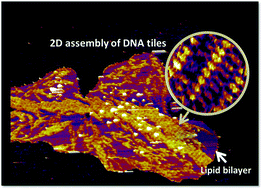Amphiphilic DNA tiles for controlled insertion and 2D assembly on fluid lipid membranes: the effect on mechanical properties†
Abstract
Future lipid membrane-associated DNA nanostructures are expected to find applications ranging from synthetic biology to nanomedicine. Here we have designed and synthesized DNA tiles and modified them with amphiphilic covalent moieties. dod-DEG groups, which consist of a hydrophilic diethylene glycol (DEG) and a hydrophobic dodecyl group, are introduced at the phosphate backbone to create amphiphilic DNA strands which are subsequently introduced into one face of the DNA tiles. In this way the tile becomes able to stably bind to lipid membranes by insertion of the hydrophobic groups inside the bilayer core. The functionalized tiles do not aggregate in solution. Our results show that these amphiphilic DNA tiles can bind and assemble into 2D lattices on both gel and fluid lipid bilayers. The binding of the DNA structures to membranes is dependent on the lipid phase of the membrane, the concentration of Mg2+ cations, the length of the amphiphilic modifications to the DNA as well as on the density of the modifications within the tile. Atomic force microscopy-based force spectroscopy is used to investigate the effect of the inserted DNA tiles on the mechanical properties of the lipid membranes. The results indicate that the insertion of DNA tiles produces an approx. 20% increase of the bilayer breakthrough force.



 Please wait while we load your content...
Please wait while we load your content...